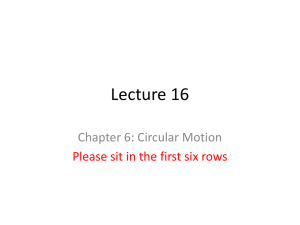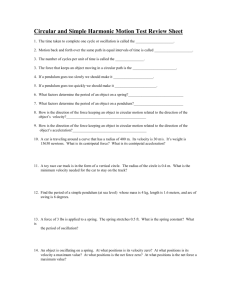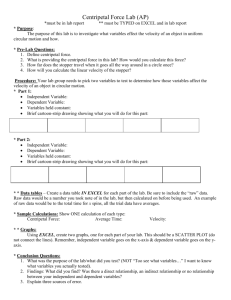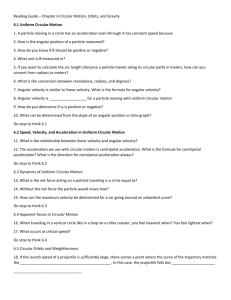IB Circ Motion ang displ velocity - Red Hook Central School District
advertisement
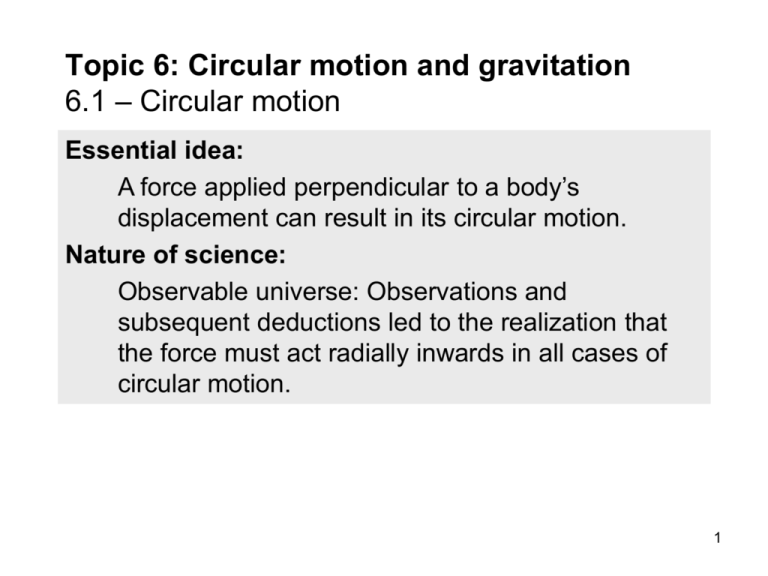
Topic 6: Circular motion and gravitation 6.1 – Circular motion Essential idea: A force applied perpendicular to a body’s displacement can result in its circular motion. Nature of science: Observable universe: Observations and subsequent deductions led to the realization that the force must act radially inwards in all cases of circular motion. 1 Topic 6: Circular motion and gravitation 6.1 – Circular motion Understandings: • Period, frequency, angular displacement and angular velocity • Centripetal force • Centripetal acceleration 2 Topic 6: Circular motion and gravitation 6.1 – Circular motion Applications and skills: • Identifying the forces providing the centripetal forces such as tension, friction, gravitational, electrical, or magnetic • Solving problems involving centripetal force, centripetal acceleration, period, frequency, angular displacement, linear speed and angular velocity • Qualitatively and quantitatively describing examples of circular motion including cases of vertical and horizontal circular motion 3 Topic 6: Circular motion and gravitation 6.1 – Circular motion Guidance: • Banking will be considered qualitatively only Data booklet reference: • v = r • a = v 2 / r = 4 2r / T 2 • F = mv 2 / r = m2r 4 Topic 6: Circular motion and gravitation 6.1 – Circular motion International-mindedness: • International collaboration is needed in establishing effective rocket launch sites to benefit space programs Theory of knowledge: • Foucault’s pendulum gives a simple observable proof of the rotation of the earth, which is largely unobservable. How can we have knowledge of things that are unobservable? 5 Topic 6: Circular motion and gravitation 6.1 – Circular motion Utilization: • Motion of charged particles in magnetic fields (see Physics sub-topic 5.4) • Mass spectrometry (see Chemistry sub-topics 2.1 and 11.3) • Playground and amusement park rides often use the principles of circular motion in their design 6 Topic 6: Circular motion and gravitation 6.1 – Circular motion Aims: • Aim 6: experiments could include (but are not limited to): mass on a string; observation and quantification of loop-the-loop experiences; friction of a mass on a turntable • Aim 7: technology has allowed for more accurate and precise measurements of circular motion, including data loggers for force measurements and video analysis of objects moving in circular motion 7 Topic 6: Circular motion and gravitation 6.1 – Circular motion Centripetal force and acceleration What force must be applied to Helen to keep her moving in a circle? How does it depend on the Helen’s radius r ? How does it depend on Helen’s velocity v? r How does it depend m v on Helen’s mass m? On the next pass, however, Helen failed to clear the mountains. 8 Topic 6: Circular motion and gravitation 6.1 – Circular motion Centripetal force and acceleration A particle is said to be in uniform circular motion if it travels in a circle (or arc) with constant speed v. Observe that the velocity vector is always tangent to the circle. Note that the magnitude of the velocity vector is v red NOT changing. r blue y Note that the direction of the velocity v vector IS changing. r Thus, there is an acceleration, even though the speed is not changing! x 9 Topic 6: Circular motion and gravitation 6.1 – Circular motion Centripetal force and acceleration To find the direction of the acceleration (a = v / t ) we observe two nearby snapshots of the particle: The direction of the acceleration is gotten from v = v2 – v1 = v2 + (-v1): The direction of the acceleration is toward the v red center of the circle - you must be able to sketch this. r blue v2 y v2 v1 -v1 v -v1 v 1 v x FYI Centripetal means center-seeking. 10 Topic 6: Circular motion and gravitation 6.1 – Circular motion Centripetal force and acceleration How does centripetal acceleration ac depend on r and v? To explore this we define the centripetal force Fc: Fc = mac centripetal force Picture yourself as the passenger in a car that is rounding a left turn: The sharper the turn, the harder you and your door push against each other. (Small r = big Fc.) The faster the turn, the harder you and your door push against each other. Fc (Big v = big Fc.) 11 Topic 6: Circular motion and gravitation 6.1 – Circular motion Centripetal force and acceleration We know the following things about ac: If v increases, ac increases. v first guess a = If r increases, ac decreases. c r formula From dimensional analysis we have ? 1 m/s m ? ac = v = = r s2 m s What can we do to v or r to “fix” the units? ac = v 2 / r centripetal acceleration 2 v ac = r This is the correct one! 2/s2 ? m m m ? = 2 = 2 s m s 12 Topic 6: Circular motion and gravitation 6.1 – Circular motion Solving centripetal acceleration and force problems Fc = mac centripetal force ac = v 2 / r centripetal acceleration EXAMPLE: A 730-kg Smart Car negotiates a 30. m radius turn at 25. m s-1. What is its centripetal acceleration and force? What force is causing this acceleration? SOLUTION: ac = v2 / r = 252 / 30 = 21 m s-2. Fc = mac = (730)(21) = 15000 n. The centripetal force is caused by the friction force between the tires and the pavement. 13 Topic 6: Circular motion and gravitation 6.1 – Circular motion Period and frequency The period T is the time for one complete revolution. The frequency f (measured in Hz or cycles / s) is defined as how many cycles (oscillations, repetitions, revolutions) occur each second. Since period T is seconds per revolution, frequency must be 1 / T. f=1/T or T = 1 / f relation between T and f EXAMPLE: Find the period and the frequency of a day. SOLUTION: The period is T = (24 h)(3600 s h-1) = 86400 s. The frequency is f = 1 / T = 1 / 86400 = 1.1610-5 Hz. 14 Topic 6: Circular motion and gravitation 6.1 – Circular motion Period and centripetal acceleration Sometimes the period of a revolution is given, rather than a velocity. One revolution is one circumference C = 2r. Therefore v = distance / time = 2r / T. Thus v 2 = 4 2 r 2 / T 2 so that ac = v 2 / r = 4 2 r 2 / T 2r = 4 2 r / T 2. ac = v 2 / r ac = 4 2 r / T 2 centripetal acceleration 15 Topic 6: Circular motion and gravitation 6.1 – Circular motion Solving centripetal acceleration and force problems ac = v 2 / r centripetal ac = 4 2 r / T 2 acceleration EXAMPLE: Albert the 2.50-kg physics cat is being swung around by a string harness having a radius of 3.00 meters. He takes 5.00 seconds to complete one fun revolution. What are ac and Fc? Albert SOLUTION: the 2 2 ac = 4 r / T Physics = 4 2 (3) / (5)2 = 4.74 m s-2. Cat Fc = mac = (2.5)(4.74) = 11.9 n. The tension is causing the centripetal 16 force, so the tension is Fc = 11.9 n. Angular displacement and arc length the rotating arm has 6 paint cans along its radius. Each can is opened for a quarter s of a revolution. s is the angular displacement. All 6 color trails have the same s s s angular displacements of 90˚. Each color traces out a different displacement s. s is the arc length = linear d. 17 Angular Displacement Angular displacement and arc length s. Angle measured in Radians. rad = 180° = 1/ 2 rev 2 rad = 360° = 1 rev radian-degree-revolution conversions From the above conversions there are 2 rad in 360˚. 18 EXAMPLE 1: Convert 30 into radians (rad) and convert 1.75 rad to degrees. SOLUTION: 30( rad / 180° ) = 0.52 rad. 1.75 rad ( 180° / rad ) = 100°. 19 Angular displacement and arc length The relationship between angular displacement and arc length s is s=r in radians relation between s and EXAMPLE 2: Suppose the red line is located at a radius of 1.50 m and the green line is located at 1.25 m. Find their lengths. SOLUTION: 90( rad / 180°) = 1.57 rad. s = r = 1.501.57 = 2.4 m. s = r = 1.251.57 = 2.0 m. 20 Angular Speed • = /t • angular speed = angular displacement / time • rad/sec 21 Topic 6: Angular speed and speed s=r in radians relation between s and The arc length s is simply the displacement, and is the s that is in s = ut + (1/2) at 2. Because speed is v = s / t, v=s/t (definition of speed) = ( r ) / t (substitution) =r(/t) =r (define / t ) v=r = / t (rad s-1) relation between v and = angular speed. 22 Topic 6: Circular motion and gravitation Angular speed and speed v=r = / t (rad s-1) relation between v and EXAMPLE 3: Consider the following point mass moving at a constant speed v in a circle of radius r as shown. v Find … r (a) the period T of the point mass, and (b) the frequency f of the point mass, and (c) the angular speed of the point mass. SOLUTION: We need a time piece. For one revolution the period is T = 12 s. Frequency f = 1 / T = 1 / 12 = 0.083 s. 23 Angular speed is = / t = 2 rad / 12 s = 0.52 rad s-1. Topic 6: Circular motion and gravitation Angular speed and speed v=r = / t (rad s-1) relation between v and EXAMPLE: Find the angular speed of the second hand on a clock. Then find the speed of the tip of the hand if it is 18.0 cm long. SOLUTION: A second hand turns 2 rad each 60 s. Thus it has an angular speed given by = 2 / T = 2 / 60 = 0.105 rad s-1. The speed of the tip is given by v = r = 0.180(0.105) = 0.0189 ms-1. FYI Speed depends on length or position but angular speed does not. 24 Topic 6: Circular motion and gravitation 6.1 – Circular motion Angular speed and speed v=r = / t (rad s-1) relation between v and EXAMPLE: A car rounds a 90° turn in 6.0 seconds. What is its angular speed during the turn? SOLUTION: Since needs radians we begin by converting : = 90°( rad / 180° ) = 1.57 rad. Now we use = / t = 1.57 / 6.0 = 0.26 rad s-1. 25 Topic 6: Circular motion and gravitation 6.1 – Circular motion Banking The car is able to round the curve because of the friction between tire and pavement. The friction always points to the center of the circle. So, how does a plane follow a circular trajectory? There is no sideways friction force that the plane can use because there is no solid friction between the air and the plane. 26 Topic 6: Circular motion and gravitation 6.1 – Circular motion Banking Using control surfaces on the tail and the main wings, planes can execute three types of maneuver: ROLL – Ailerons (little wing flaps) act in opposing directions YAW – Tail rudder turns left or right PITCH – Ailerons and horizontal stabilizer act together FYI It is the ROLL maneuver that gives a plane a centripetal force as we will see on the next slide. 27 Topic 6: Circular motion and gravitation 6.1 – Circular motion Banking As the plane banks (rolls), the lift vector begins to have a horizontal component. The centripetal force causes the plane to begin traveling in a horizontal circle. 28 Topic 6: Circular motion and gravitation 6.1 – Circular motion Banking Even though cars use friction, roads are banked so that the need for friction is reduced. Instead of a component of the LIFT force providing a centripetal force, a component of the NORMAL force does so. R FC W FYI A banked curve can be designed so that a car can make the turn even if it is perfectly frictionless! 29 Topic 6: Circular motion and gravitation 6.1 – Circular motion Angular speed and centripetal acceleration Sometimes the angular speed of an object in circular motion is given, rather than its velocity. From v = r we get v 2 = r 2 2. From ac = v 2 / r we get ac = r 2 2 / r ac = r 2. Putting it all together we have ac = v 2 / r ac = 4 2 r / T 2 ac = r 2 Fc = mv 2 / r Fc = 4 2 mr / T 2 Fc = m 2 r ac and Fc (all three forms) 30 Topic 6: Circular motion and gravitation 6.1 – Circular motion Angular velocity = 2 / T = 2f = / t relation between , T and f As speed with a direction is called velocity, angular speed with a direction is called angular velocity. To assign a direction to a rotation we v use a right hand rule as follows: r 1. Rest the heel of your right hand on the rotating object. 2. Make sure your fingers are curled in the direction of rotation. FYI Angular 3. Your extended thumb points velocity always points in the direction of the angular perpendicular to the 31 velocity. plane of motion! Topic 6: Circular motion and gravitation 6.1 – Circular motion Angular velocity = 2 / T = 2f = / t relation between , T and f PRACTICE: Find the angular velocity (in rad s-1) of the wheel on the shaft. It is rotating at 30.0 rpm (revolutions per minute). SOLUTION: The magnitude of is given by = (30.0 rev / 60 s)(2 rad / rev) = 3.14 rad s-1. The direction of is given by the right hand rule: “Place heel of right hand so fingers are curled in direction of rotation. Thumb gives the direction.” 32 Topic 6: Circular motion and gravitation 6.1 – Circular motion Identifying the forces providing centripetal forces PRACTICE: Identify at least five forces that are centripetal in nature: SOLUTION: The tension force (Albert the physics cat and Arnold). The friction force (the race car making the turn). The gravitational force (the baseball and the earth). The electric force (an electron orbiting a nucleus). The magnetic force (a moving charge in a B-field). 33 Topic 6: Circular motion and gravitation 6.1 – Circular motion Solving centripetal acceleration and force problems PRACTICE: Dobson is watching a 16-pound bowling ball being swung around at 50 m/s by Arnold. If the string is cut at the instant the ball is next to the ice cream, what will the ball do? (a) It will follow path A and strike Dobson's ice cream. (b) It will fly outward along curve path B. (c) It will fly tangent to the original circular path along C. A C 34 B Topic 6: Circular motion and gravitation 6.1 – Circular motion Solving centripetal acceleration and force problems EXAMPLE: Suppose a 0.500-kg baseball is placed in a circular orbit around the earth at slightly higher that the tallest point, Mount Everest (8850 m). Given that the earth has a radius of RE = 6400000 m, find the speed of the ball. SOLUTION: The ball is traveling in a circle of radius r = 6408850 m. Fc is caused by the weight of the ball so that Fc = mg = (0.5)(10) = 5 n. Since Fc = mv 2 / r we have 5 = (0.5)v 2 / 6408850 v = 8000 m s-1! 35 Topic 6: Circular motion and gravitation 6.1 – Circular motion Solving centripetal acceleration and force problems EXAMPLE: Suppose a 0.500-kg baseball is placed in a circular orbit around the earth at slightly higher that the tallest point, Mount Everest (8850 m). How long will it take the ball to return to Everest? SOLUTION: We want to find the period T. We know that v = 8000 m s-1. We also know that r = 6408850 m. Since v = 2r / T we have T = 2r / v T = 2(6408850)/ 8000 = (5030 s)(1 h / 3600 s) = 1.40 h. 36 Topic 6: Circular motion and gravitation 6.1 – Circular motion Solving centripetal acceleration and force problems EXAMPLE: Explain how an object can remain in orbit yet always be falling. SOLUTION: Throw the ball at progressively larger speeds. In all instances the force of gravity will draw the ball toward the center of the earth. When the ball is finally thrown at a great enough speed, the curvature of the ball’s path will match the curvature of the earth’s surface. The ball is effectively falling around the earth! 37 Topic 6: Circular motion and gravitation 6.1 – Circular motion Solving centripetal acceleration and force problems PRACTICE: Find the angular speed of the minute hand of a clock, and the rotation of the earth in one day. SOLUTION: The minute hand takes 1 hour to go around one time. Thus = 2 / T = 2 / 3600 s = 0.00175 rad s-1. The earth takes 24 h for each revolution so that = 2 / T = ( 2 / 24 h )( 1 h / 3600 s ) = 0.0000727 rad s-1. This small angular speed is why we can’t really feel the 38 earth as it spins. Topic 6: Circular motion and gravitation 6.1 – Circular motion Solving centripetal acceleration and force problems EXAMPLE: The Foucault pendulum is a heavy pendulum on a very long cable that is set in oscillation over a round reference table. Explain how it can be used to tell time. SOLUTION: The blue arcs represent the motion of the pendulum bob relative to the universe at large. The the green lines represent the plane of motion of the pendulum relative to the building. 39 Topic 6: Circular motion and gravitation 6.1 – Circular motion Solving centripetal acceleration and force problems EXAMPLE: The Foucault pendulum is a heavy pendulum on a very long cable that is set in oscillation over a round reference table. Explain how it can be used to tell time. SOLUTION: Since the building is rotating with the earth at = 0.0000727 rad s-1, each hour the green line rotates by = t = 0.0000727(3600) = 0.262 rad (360/ 2 rad) = 15.0. FYI This solution only works when the pendulum is at one of the poles. See the Wiki for a general solution. 40 Topic 6: Circular motion and gravitation 6.1 – Circular motion Solving centripetal acceleration and force problems 90˚ EXAMPLE: Find the apparent weight of someone standing on an equatorial scale r if his weight is 882 N at the north pole. R SOLUTION: Recall that = 0.0000727 0˚ rad s-1 anywhere on the earth. The blue arcs represent the lines of latitude. The white line R represents the earth’s radius. The yellow line r represents the radius of the circle a point at a latitude of follows. Note that r = R cos , and that at the equator, = 0˚ and at the pole, = 90˚. 41 Topic 6: Circular motion and gravitation 6.1 – Circular motion Solving centripetal acceleration and force problems EXAMPLE: Find the apparent weight of someone standing on an equatorial scale r if his weight is 882 N at the north pole. R SOLUTION: Recall that = 0.0000727 rad s-1 anywhere on the earth. Thus, at the equator, r = R, and at the pole, r = 0. Furthermore, R = 6400000 m. Then, at the equator, ac = r 2 = 6400000 0.00007272 = 0.0338 ms-2. Then, at the pole, ac = r 2 = 0 0.00007272 = 0.000 ms-2. 42 Topic 6: Circular motion and gravitation 6.1 – Circular motion Solving centripetal acceleration and force problems EXAMPLE: Find the apparent weight of someone standing on an equatorial scale if his weight is 882 N at the north pole. W R SOLUTION: Make a free-body diagram at the equator… ac Scales read the normal force R: F = ma R – W = - mac R = W – mac Then, R = 882 – ( 882 / 9.8 ) 0.0338 = 879 N. The man has apparently “lost” about 3 N! 43 Topic 6: Circular motion and gravitation 6.1 – Circular motion Solving centripetal acceleration and force problems Use F = kx (k = CONST). kx = FC = r implies that as v increases, so does the centripetal force FC needed to move it in a circle. Thus, x increases. mv 2/ 44 Topic 6: Circular motion and gravitation 6.1 – Circular motion Solving centripetal acceleration and force problems kx = F k = F / x = 18 / 0.010 = 1800 Nm-1. FC = kx = 1800( 0.265 – 0.250 ) = 27 N. FC = v 2/ r v 2 = r FC = 0.265(27) = 7.155 v = 2.7 ms-1. 45 Topic 6: Circular motion and gravitation Use v = r ( = CONST). 6.1 – Circular motion Use a = r 2 ( = CONST). Solving centripetal acceleration and force problems At P r=R v = R a = R 2 At Q r = 2R v = 2R =462v a = 2R 2 = 2a Topic 6: Circular motion and gravitation 6.1 – Circular motion Solving centripetal acceleration and force problems Objects moving in uniform circular motion feel a centripetal (center-seeking) force. 47


